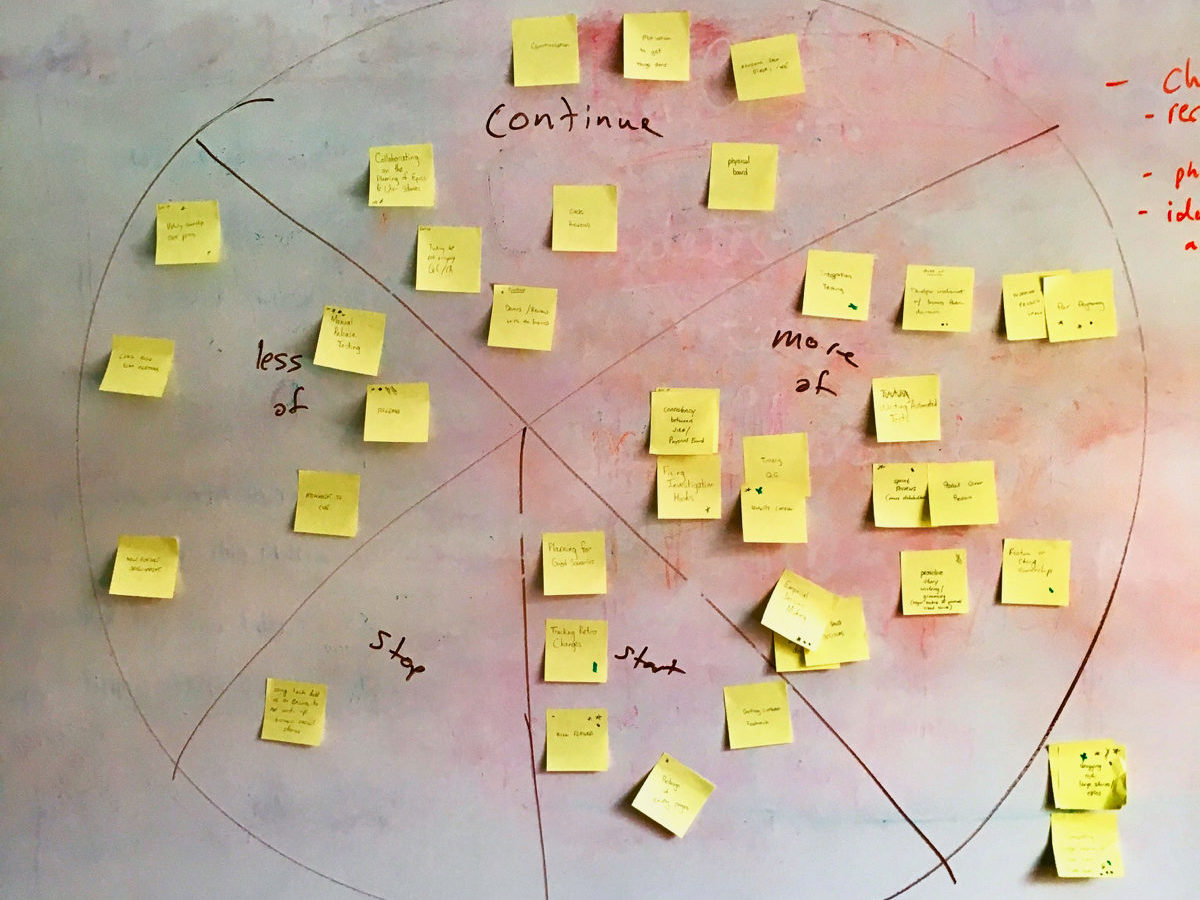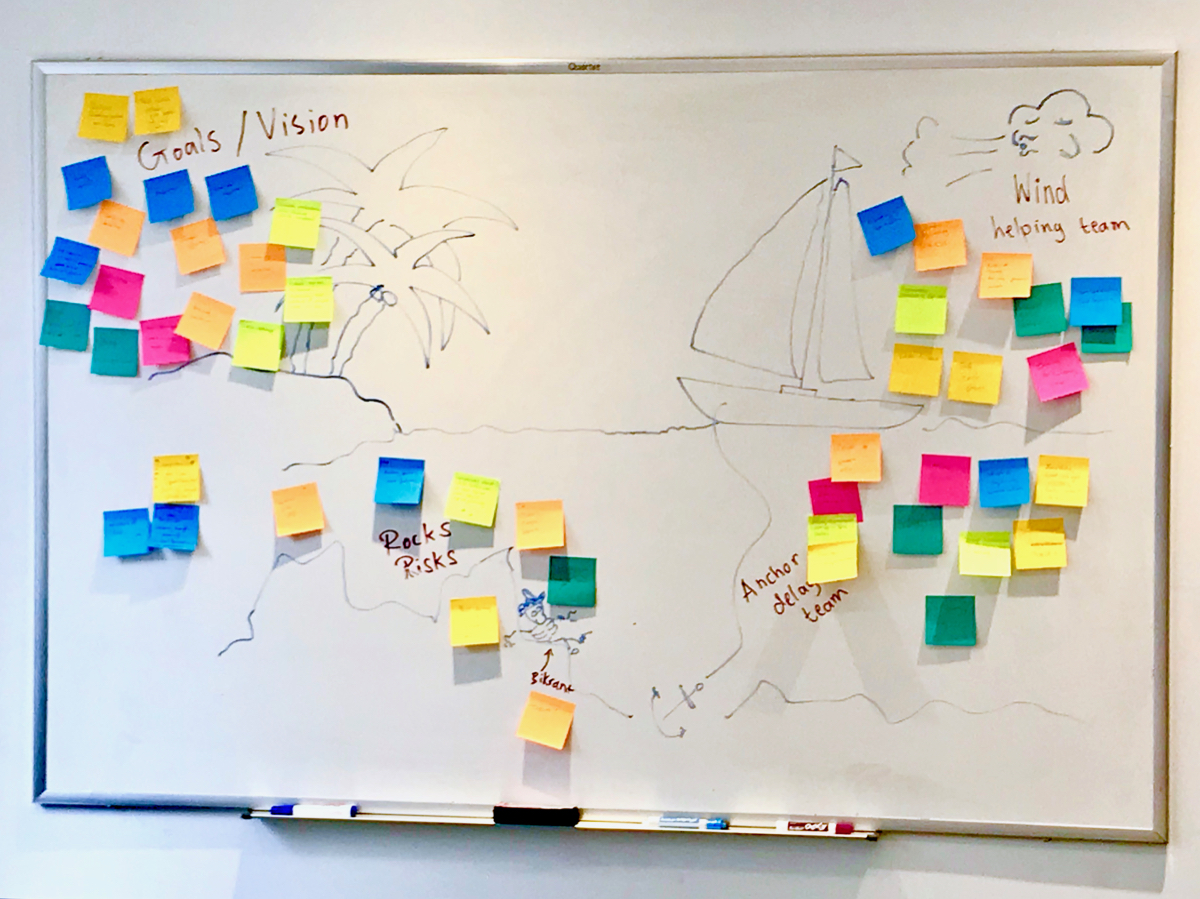Retrospective Variety – A Key To Growth
- Pat Guariglia
- Jul, 08, 2019
- agile coaching, retrospectives, Scrum Master
- No Comments


Retrospective Variety is the spice of life
Don’t get stuck in a retrospective rut. There are literally dozens and dozens of techniques one can use to spice things up for your team. Retrospective variety is the key to growth and maturation in a team. Too many Scrum Masters and agile-team facilitators use the same retrospective technique over and over again. There are a number of problems with this.Problems with the lack of variety
- Boring – Let’s be honest, it’s boring. Doing the same thing again and again is going to get dull. Mixing up the technique may bring new life to your retrospective.
- Complacency – There is a level of complacency that has now settled in. It’s easier to do something that “works” instead of changing it up. The Scrum Master or facilitator is not proactively exploring new ideas for their team.
- Time – Similar responses will emerge from the team when you use the same method repeatedly. When similar responses emerge, the teams start to think there is nothing more to learn. A result of this is that retros get shorter, thus perpetuating the problem. Since many retrospectives have this issue, the teams decide to shrink their retros down from 1.5 hours to 30 minutes. If the team happens to change to a new style of retrospective, they will try to fit into this shortened time window of 30 minutes. What happens? Well, it doesn’t go so well. They will likely run out of time and not everyone gets to speak and improvements are not fully committed to or discussed.
- Personality – Not everyone responds the same way to retrospective techniques, so try changing it up. We all have different personality types, so it makes sense to vary our techniques. Varying our techniques will help to reach different people at different times. Read more on this here: Quiet Expression – Inclusive Retrospectives for Agile Teams.
Try one of these
Here are some examples of retrospectives that I find useful and relatively easy to implement. These examples go beyond the “what went well, what didn’t go well…” question set. By varying your retrospective approaches, you may see new life and excitement emerge from your team. The following examples should follow the basic five stages of a retrospective developed by Esther Derby and Diana Larson: Set the Stage, Gather Data, Generate Insights, Decide What to Do, Close the Retrospective.Starfish
This is a super simple technique that utilizes five main talking points (continue, more of, less of, start, stop). The five items are placed in between the lines of the “starfish” pattern. The pattern is made by joining the five lines of the “starfish” on one end while the other ends are fanned out. It almost looks like an asterisk (*). Starfish have five legs. (see picture above)- Put the starfish on the wall or create a digital document for remote teams. Write “continue”, “more of”, “less of”, “stop”, “start” in each of the wedges created by the legs.
- Give the team a 5-10 minute time box to silently write things on post-it notes for each of the five topics.
- After the time box is up, have them put the post-its on the starfish in the appropriate place.
- Go through each one and identify potential improvements. Don’t take just the surface response for each one, dig a little deeper. If you identify an improvement, take another colored post-it note, write the improvement down and stick it on top of the other original.
- After going through each one, do some dot voting in order to isolate/prioritize the improvements you can do for the next iteration.
Sailboat or Speedboat
For the sailboat or speedboat (I prefer the sailboat), you are going to draw a boat at sea with various scenery adorning it. Each piece of the scenery is symbolic to the team’s world. The boat itself represents the team.- Use a large whiteboard or flip chart and draw the following: sailboat floating in water, shark fin behind the boat, a tropical island in front of the boat in the distance, a sun with a smilie face, an anchor dragging in the water, some cargo on the boat. Each of these items represents something to the team. The sailboat is the team and everything in its world affects the team/boat. The sail on the boat represents things that speed or propel the sailboat. The shark fin represents risks or dangers which “lurk” under the water. The smiling sun represents things that makes the team feel good, happy or brightens them up. The island represents places they want to go, goals, or targets. The anchor is for things that slows the sailboat down.
- Have the team take a 5-10 minute time box to silently write things on post-it notes for each of the symbols.
- After the time box is up, have them put the post-its on the appropriate symbol on the drawing.
- Repeat steps from D – E above.
Recognition
A recognition retrospective is a good option for teams needing a break from the standard retrospective. Recognition “retros” can be used as a team-building activity, because it encourages everyone to find something positive to say about others. Here’s how it works:- Get everyone in a circle. If that’s not possible, a table is fine too. Go outside if it’s nice out and change up the atmosphere.
- Ask people to volunteer one at a time to stand up and address a person in the team who they feel needs some sort of recognition. (Sometimes you have to wait a bit before some has the courage to do this.)
- Encourage them to share their recognition of that person in front of the whole team and thank them. (The purpose of doing this is to illuminate this good deed to the rest of the team, so others can learn from it.)
- You may want to bring some gourmet chocolates, which can be used as little gifts for each person who is being recognized. Put the chocolates in the center of the room and when people get up to recognize a fellow team mate, they simple pick up the chocolate, hand the “gift” to the one being recognized and start talking.
Five Whys
The “Five Whys” technique is an old-school lean technique for discovering the root cause of an issue. It can be retrofitted for use in retrospectives to unpack process issues. Of all the retro techniques I use, this is the least “fun”, but perhaps the most intense at really getting down and dirty with an issue. Essentially, you are going to ask five variations of a why-related question to drill down on an issue. It helps with critical thinking and getting beyond the first response to a question in a more disciplined way. Make sure you ask the team ahead of time if they are ok with this approach, because it can feel a little like an interrogation. I have used this with teams who have had major issues with defects/bugs. We could take one bug and use this technique to explore deeper. Sometimes a why question can yield more than one answer, so it is important to go down each path. In other words, there may be more than one root cause. Once you identify the root cause, try to figure out an improvement. Check out this article on the Five Whys by the Harvard Business Review.One Word
This may be one of the more simple retrospectives to facilitate, but it is one of the most provocative. The team is challenged to describe how they feel about the last sprint in only one word. Here is how this one works:- Ask the team at the beginning of the retrospective to write down one word on a post-it note that best describes or summarizes their feelings. Give them one or two minutes.
- Have team members put those post-it notes on an area of the wall.
- Pick a random one off the wall and say it out loud. Discuss it with the team by asking questions. Try encouraging the team to find out what that one word means to the author.
- If an issue or opportunity for improvement is related to the word, try finding out how to make an actionable improvement for the team. Once that’s identified, put a new (different colored post-it) on top of the one word to mark it as an improvement item.
Final notes
The above suggestions will help you add a few more arrows to your quiver, but always remember to walk away with actionable improvements. It is also worth mentioning how important it is to start off each retrospective by creating a safe space. Find ways to establish trust and openness, and if needed, remind the team that we need to respect each other and their feelings.Please share your thoughts or share this post!